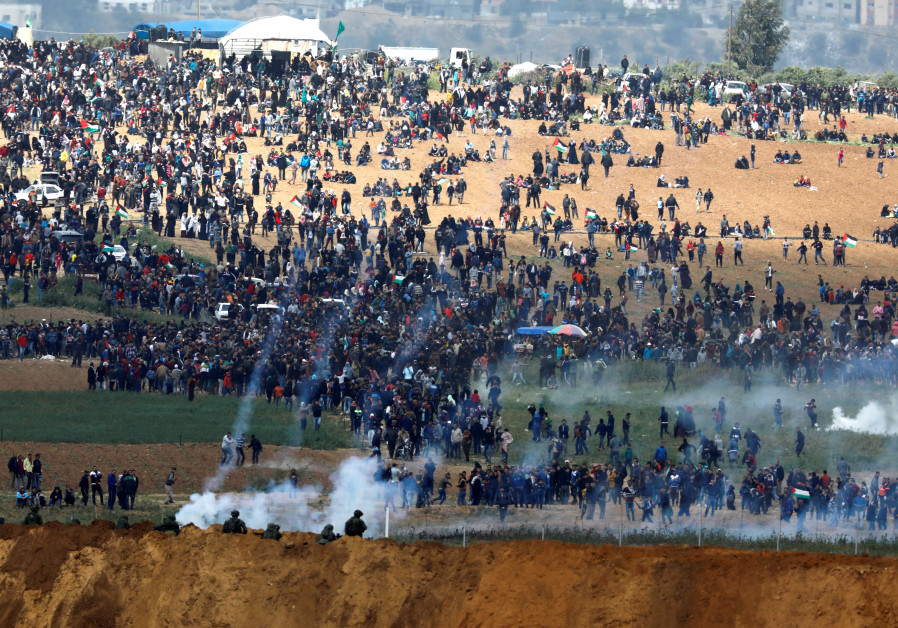Three weeks: How Gaza’s mass protests are failing to make an impact

Israeli soldiers shoot tear gas from the Israeli side of the Israel-Gaza border, as Palestinians protest on the Gaza side of the border, March 30, 2018.. (photo credit: AMIR COHEN/REUTERS)
The ‘Great Return March protests that Hamas and Gaza activists launched on March 30th saw their lowest turnout in three weeks and the smallest number of casualties in clashes with Israeli forces. Israeli authorities have been steadfast and on message about the protesters being a cover for violent action while Hamas and the local activists have attempted to keep up the momentum. The percent of those injured by live fire has declined by half, indicating a major reduction not only in the size of the protests but the level of violence along the border.
On the eve of the third Friday of mass protests in Gaza, the Hamas run Palestinian Ministry of Health in Gaza published a list of casualties from the past two weeks. With an infographic they said that 3,078 Palestinians had been injured, including 1,236 with live ammunition. They claimed 4 people had lost legs. Of those injured 445 were under 18 and 152 were women. 30 had been killed. They also said 30 paramedics had been injured and 14 journalists, including Yaser Murtaja who was shot on April 6.
This Friday the protests didn’t reach the levels they had in the past. Israel Defense Minister Avigdor Liberman tweeted that “from week to week there are fewer riots on our border with Gaza. Our resolve is well understood from the other side.” The IDF tweeted that 10,00 had participated in the “rioting” on the border. They also posted a photo showing a “terrorist wielding an item suspected of being an explosive device” while crouching next to journalists and a handicapped person. IDF spokesperson Jonathan Conricus also claimed that the public should take note that the demonstration is a Hamas attempt to terrorize Israel and is backed by Iran.
By nightfall reports indicated one Palestinian had been killed and 528 wounded. This was a major decline than the last two Fridays the protests have been held. On March 30th a total of 17 people were killed and 1,416 wounded, according to health officials in Gaza. On April 6 nine more were killed and 1,354 wounded. The numbers injured by live fire have also declined from a high of 53% of those injured on March 30 to a low of 23% of those injured on April 13. These numbers are based on calculations derived from the Palestinian health sources, and the numbers point to a major reduction in use of live fire by the IDF. There is no independent confirmation of these figures. The IDF itself has not released all the details of how it operates on the border but it has stressed that it will not allow any breach of the “security infrastructure” and that it will “fire in according with the rules of engagement.”
Israel’s use of sniper fire on the border has been criticized and international organizations from the UN to EU have expressed concern. B’tselem released a statement on April 3 saying Israeli soldiers “must refuse to fire at unarmed protesters.” It seems that after the March 30 protests that some of the concerns and critiques were taken into account because Israel has sought to stress that it was seeking to defend the border fence with a minimal number of casualties. The IDF had also released information after the first Friday’s protests claiming that 10 of those killed were active Hamas members.
The number of protesters who gather each Friday has decreased. At their height they numbered 20,000 or more but they have decreased first to 17,000 and an estimated 10,000 on April 13. The attempt by the protesters to use mass burning of tires on April 6th also didn’t work as they planned.
There has been almost no mass protests in the West Bank to coincide with the Gaza clashes. There are several reasons for this, one of which has to do with political divisions between Gaza and the West Bank. There may also be less solidarity between the two areas, different economic concerns and also messages from authorities about the protests. Whatever the real reason for the lack of response it shows that Hamas and the Gaza activists have failed so far. They want to keep the pressure up until mid-May, but it’s unclear how the momentum will work. One problem they face is that they are only doing it on Fridays and this does not constitute a true mass civil disobedience campaign. Israel has also succeeded in showing that the protests have a violent element to them. Even in the case of the Murtaja, the killed cameraman, Israel has said he was an active Hamas member, leading to recriminations on both sides about his role.
The Gaza protests are also overshadowed by the chemical weapons attacks in Syria and other issues. That doesn’t mean there will not be investigations or condemnation of Israel for the actions in Gaza. But so far the level of condemnations or criticism has been relatively mooted compared to past conflicts. Within Israel as well there appears to be very little concern for Gaza and much more understanding for the need to defend the fence. Even a video that emerged on April 7 showing a sniper shooting a Palestinian, which allegedly took place months ago, did not turn into the “new Elor Azaria” case that some predicted it might.





Comments are closed.